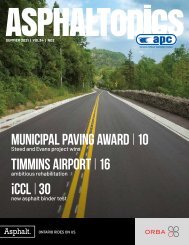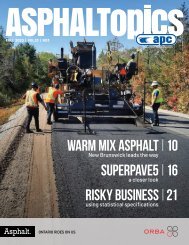ASPHALTopcs | Summer 2017 | VOL 30 | NO 2
You also want an ePaper? Increase the reach of your titles
YUMPU automatically turns print PDFs into web optimized ePapers that Google loves.
Paving the way with frien<br />
The Asphalt Pavement Alliance (APA)<br />
with Amy Miller, National Director<br />
Can you give us a brief history on the<br />
origin of your organization?<br />
The Asphalt Pavement Alliance (APA) was<br />
started in 2000 by the National Asphalt<br />
Pavement Association (NAPA), the Asphalt<br />
Institute (AI) and the State Asphalt Pavement<br />
Associations (SAPA). Initially, the Alliance<br />
was a volunteer organization, but as it grew<br />
it was staffed with full-time employees. The<br />
goal of the Alliance was to have an organized<br />
means to combine resources and focus on<br />
initiatives that are common to the three<br />
major asphalt associations.<br />
Can you report on changes to your<br />
organization and how they are working?<br />
A primary focus of the APA is to deploy<br />
research material developed by the Pavement<br />
Economics Committee (PEC), which is<br />
supported by NAPA and SAPA, as well as<br />
marketing material developed by the Go To<br />
Market committee, which is solely supported<br />
by NAPA. Technical reports are transferred<br />
to the Go To Market, and the committee<br />
finesses the material so that it can be<br />
used by industry. The deployment work of<br />
APA is very important to ensure that this<br />
information gets out to the audience to<br />
which it was intended. The APA deploys<br />
this material both nationally and regionally.<br />
The regional approach is the newest<br />
change to the APA. We hired a regional<br />
director, Dan Stabell, who is responsible<br />
for the northcentral region. In July 2016, he<br />
conducted the first major regional meeting in<br />
the Northcentral region. The APA deployment<br />
team has also held meetings in the Northeast<br />
and Southeast regions. These meetings have<br />
been instrumental in discussing efforts<br />
related to regional issues and developing<br />
initiatives that allow focused deployment of<br />
strategic information. Eventually, we plan to<br />
have regional directors for all five regions –<br />
Northeast, Southeast, Northcentral, Rocky<br />
Mountains and Western.<br />
Each region has a council that is made up<br />
of state asphalt executives, NAPA staff and<br />
membership, and Asphalt Institute staff<br />
and membership. The goal of this council<br />
is to establish needed directives that will<br />
incorporate current PEC deliverables as well<br />
as establish regional directives handled by<br />
the council. An annual review of our work<br />
in these regions will ensure that we are<br />
deploying the needed information, that<br />
we’re staying on target and that our<br />
initiatives are being completed.<br />
What are you currently working on?<br />
We have an overseeing committee that<br />
puts a stamp of approval on the initiatives<br />
of the deployment of the APA. Right now,<br />
we are focused on deploying materials<br />
that are related to Life Cycle Cost Analysis<br />
(LCCA). Also, we are reminding operators<br />
not to overlook the opportunities that exist<br />
with the commercial market. This would<br />
include anything that is not a Department<br />
of Transportation project, such as parking<br />
lots. Traditionally, the asphalt industry has<br />
not focused on the commercial market. The<br />
competition, however, is making inroads here,<br />
so as an industry we are stepping up efforts.<br />
We’re also pushing for the implementation of<br />
PaveExpress, which is a free online software<br />
to design rigid and flexible pavements (www.<br />
pavexpressdesign.com). This is a deliverable<br />
of the PEC that has been very successful.<br />
This web-based software tool continues to<br />
draw attention from designers and engineers<br />
around the world. Enhancements continue to<br />
be added to the software, which improves the<br />
efficiency and accuracy of pavement design<br />
for more robust pavements.<br />
The APA is also responsible for the National<br />
Perpetual Pavement Award. The Alliance first<br />
defined perpetual pavements in 2000 and<br />
established the Perpetual Pavement Award<br />
in 2001. Since then, 118 pavements in <strong>30</strong><br />
U.S. states and one Canadian province have<br />
been honoured with the award. Recipients<br />
are state transportation departments and<br />
local agency road owners who have wellperforming<br />
asphalt pavements that are<br />
at least 35 years old. Winners of the 2016<br />
Perpetual Pavement Award included 10<br />
departments of transportation.<br />
APA continues to represent the asphalt<br />
industry at various trade shows, including<br />
events put on by the International Council of<br />
Shopping Centres (ICSC) and large national<br />
trade shows. Participation in these forums<br />
increases awareness about APA and the<br />
issues that are current and relevant to the<br />
asphalt industry.

















